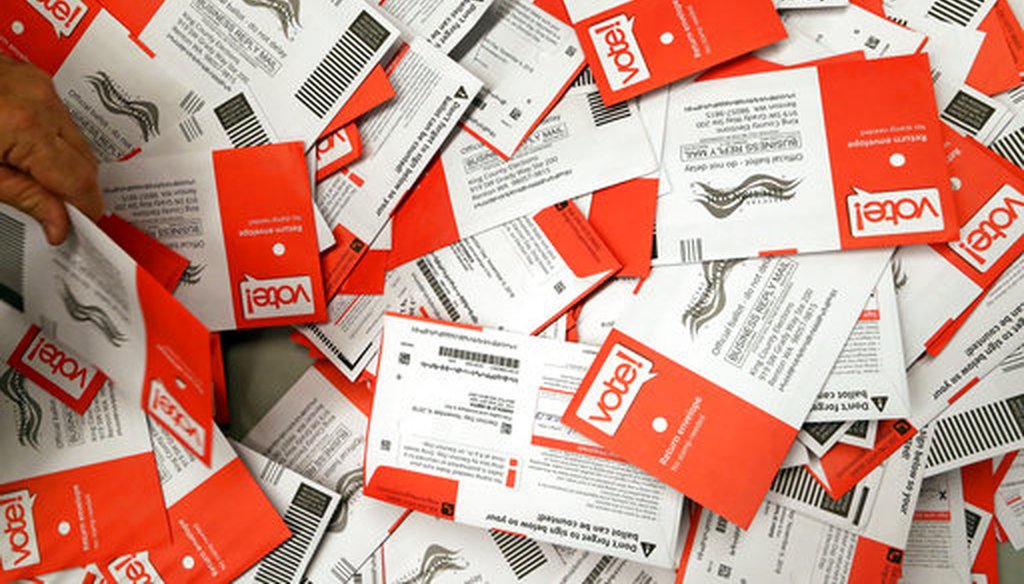Get PolitiFact in your inbox.

A batch of ballots collected from drop boxes at the King County Elections office in Renton, Wash. (AP)
If Your Time is short
• Once you have your ballot in hand, take your time and follow all instructions, including signing the envelope and providing any other information required.
• To reduce the likelihood that your mail ballot is rejected, election officials and experts urge voters to return their ballot well before Election Day.
• If your state allows it, consider dropping your ballot off at official lockboxes located at polling places or election offices.
• Track your ballot’s progress online if your jurisdiction offers that option, and be on the lookout for any communications from election officials that your ballot needs to be corrected before Election Day.
Due to the coronavirus pandemic, voters in many states are preparing to vote by an unfamiliar method: by mail.
Traditionally, most of the voting in most states is done in person, either before or on Election Day. But in recent months, health officials have encouraged voters to cast their ballots by mail so they can avoid getting infected at crowded polling places on Election Day.
In response, a wide range of states (though not all) have eased the process of mail voting, often by eliminating the need for an "excuse" to vote by mail. A few states are going so far as to send ballots to every active registered voter.
This map summarizes which states will be sending ballots automatically (dark orange) and which ones allow voters to request ballots without having to demonstrate their infirmity or planned travel out of state (light orange).
In addition to reducing the risk of infection, voting by mail can increase voter turnout by enabling voters to fill out their ballots at their convenience, by letting them to skip the wait at polling places, and by avoiding the need to juggle voting with their responsibilities at work or with families at home.
However, the rules for mail voting can be confusing for voters who haven’t done it before. And unlike a polling place, voting from home means you can’t walk over to an election worker to make sure you’re doing it correctly. So if you don’t follow the instructions, your ballot might not get counted.
Federal data shows that relatively few mail ballots are rejected. In 2016, about 1% were rejected, most commonly for missing or mismatched signatures, or for arriving after the deadline.
The primaries this year have offered a test run for November, and the process has not always gone smoothly. NPR found that as of mid-July, that 1% rejection rate was holding steady in most states, but in tight races, even a rejection rate of 1% can make a difference.
If your state offers early in-person voting, that may be a viable option, offering shorter lines and less risk from the virus. But for voters who remain uncomfortable with voting in person this year, mail balloting is the remaining option.
Voting by mail also raises a host of questions that voters may find unfamiliar. Will your state count a ballot if it’s postmarked by Election Day but received afterward? Can the U.S. Postal Service — which has money problems, has undergone a staff shakeup and sent warnings to states about the potential for late arriving ballots — be counted on to deliver the surge of mail ballots? What kinds of protections are used to prevent fraudulent ballots? And how long will it take to count all those ballots?
We’ll try to answer some of those questions in this article. Here’s a consensus of best practices -- vetted by election experts -- for how to make sure your mail ballot gets counted.
1. If you want a mail ballot but haven’t requested it, do it now, as long as the deadline has not already passed.
Check your local elections office to see how you can request a mail ballot. In most states, this can be done online. While you’re at it, make sure that your address is current. You may need to enter an accepted form of ID to request a mail ballot.
Most states start sending out their ballots between 30 and 45 days before the election, but check your state if you want their specific policy.
2. Give yourself a quiet, clear space in your home to fill out your ballot away from drinks, snacks, and distractions.
"Read the instructions thoroughly before filling out your ballot," said Claire DeSoi, who handles outreach at the Massachusetts Institute of Technology’s Election Data and Science Lab. "In our experience, this is a crucial step."
Take special note of all instructions about how to mark your choices, such as whether you need to fill in an oval.
3. Carefully fill out your ballot, making sure you choose only one candidate in each race, unless the ballot explicitly tells you otherwise.
Some races do ask you to choose multiple candidates, but most don’t. Also, check both sides of every page to make sure you have voted in every race or question you want to vote in.
4. Fill out every space on the envelope that requires a signature, the date, or a name.
States require a signature and possibly other information on ballot envelopes as a protection against fraud, such as someone casting more than one ballot. This information is checked against voter registration information.
The lack of a voter’s signature on an envelope, or a signature that looks different than the one on file, "is the biggest obstacle to getting a ballot counted," DeSoi said.
"While it may be impossible to remember how you signed your voter registration form if that was years ago, it’s best to avoid excessive deviation from a previous signature if possible," said Edward B. Foley, who directs the election law program at Ohio State University.
If your elections office gives you a way to add an email address or phone number to the request for a ballot or the envelope, that may help elections officials contact you quickly if they find a problem.
5. If you live in a state that requires a "witness" for voting by mail, make sure you build in enough time to get someone.
While pending litigation might affect some of these rules, a few states do require a witness or notarization.
6. Don’t panic if you make a mistake on your ballot (or if you don’t receive one).
"If a requested ballot doesn't arrive in the voter's mailbox, or the voter ‘spoils’ the ballot by making a mistake, then voting in person on Election Day is a fail-safe," said Barry C. Burden, director of the Elections Research Center at the University of Wisconsin-Madison.
7. Check to see if you need to add stamps to the envelope, and if so, how many.
Some states do not require postage for ballots, but others do. In states that require a voter to attach postage, the ballot envelope may require more than one stamp. It’s always safest to attach the appropriate number of stamps, but the Postal Service has repeatedly said it will deliver ballots even if they lack sufficient postage.
8. Avoid waiting until the last minute to mail your ballot.
This is one of the most important pieces of advice: Assuming you’ve made up your mind about who to vote for, send in your ballot as early as you can, to avoid it arriving too late to be counted.
The rules about when a ballot must be received vary by state.The chart below summarizes the deadlines.
The states in gray require ballots to be received by election officials by Election Day. The states in either shade of green are more flexible. States marked in light green require a postmark the day before Election Day, while the states in dark green require a postmark by Election Day. States that accept postmarks on or before Election Day may also require the ballots to be received within a certain number of days after the election.
The rules also vary by state on whether you can hand over your ballot to someone else to turn it in. Regardless, do not give your ballot to someone else to drop off unless it’s a trusted relative or friend.
9. Consider dropping off your ballot in person if your state allows it.
Some states allow voters to drop their mail ballot into a dropbox, or permit you to give it to an election official at a polling place or elections office. This saves a stamp, as well as any worry that the ballot will get lost in the mail, but it is more time-intensive than dropping the ballot into a U.S. Postal Service mailbox.
10. See if you can track your ballot’s progress online.
Some elections offices provide a ballot-tracking system, sometimes with the ability to sign up for messages about the status of one’s ballot. (Here is an example in Broward County, Florida.)
11. Be on the alert for a message that there’s a problem with your ballot.
In many states, you may be notified that there’s a problem with your ballot that can be fixed in time for it to be counted. Problems could include a missing signature or a signature that doesn’t match what’s on file. Typically, voters can visit an elections office to rectify the situation. If this happens to you, just follow the instructions from your elections office.
Our Sources
PolitiFact, The misleading claim that millions of absentee ballots end up ‘missing or in landfills’ June 9, 2020
Washington Post, How the U.S. Mail Became a Presidential Campaign Issue, Aug. 10, 2020
Washington Post, Postal Service warns 46 states their voters could be disenfranchised by delayed mail-in ballots, Aug. 14, 2020
Email interview with Amber McReynolds, CEO of Vote at Home, Aug. 3, 2020
Email interview with Wendy Underhill, director of elections and redistricting at the National Conference of State Legislatures, Aug. 3, 2020
Email interview with Brian Hinkle, research analyst in the elections and redistricting program at the National Conference of State Legislatures, Aug. 3, 2020
Email interview with Edward Foley, election-law specialist at Ohio State University, July 31, 2020
Email interview with Sophia Solis, spokeswoman for the Arizona Secretary of State’s office, Aug. 6, 2020
Email interview with Gail Humphrey, Bucks Co., Pa., chief clerk, July 31, 2020
Email interview, Barry Burden, director of the Elections Research Center at the University of Wisconsin-Madison, Aug. 3, 2020
Email interview, Claire DeSoi, spokesperson at MIT Election Data and Science Lab, Aug. 4, 2020
Email interview, Cheryl Couser, spokesperson at the New York State Board of Elections, Aug. 3, 2020
Email interview, Maggie Sheehan, spokesperson for Ohio Secretary of State Frank LaRose, Aug. 5, 2020






































